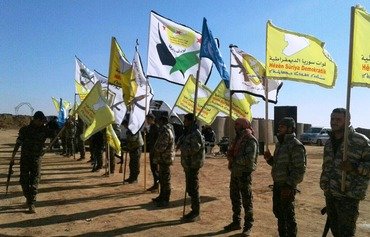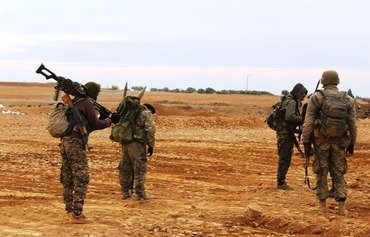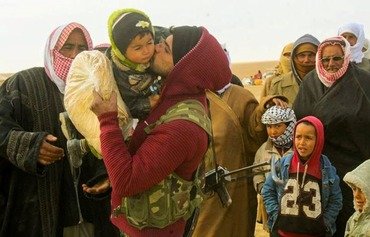The Syrian Democratic Forces (SDF) are moving in on the Syrian city of al-Raqa following the successes achieved during the first phase of a campaign to liberate the area from the "Islamic State of Iraq and the Levant" (ISIL).
On Sunday (November 27th) SDF troops were battling ISIL elements about 25 kilometres north of the city, AFP reported.
The first phase of the Wrath of the Euphrates campaign, which kicked off November 5th, saw a large number of villages and farms in the countryside around al-Raqa liberated from ISIL .
Military equipment and vehicles used by ISIL were destroyed by the SDF, an Arab-Kurd alliance whose fighters include Arabs, Kurds, Syriacs and Turkmen, and 167 of ISIL's fighters were killed during the operation.
The first phase of the campaign sought to isolate al-Raqa in preparation for the liberation of the city, SDF spokesman Brig. Gen. Talal Sello said at a November 14th press conference announcing its successful conclusion.
"Liberating the city of al-Raqa and its rural areas is not an easy task that can be completed quickly," he said.
A three-phase plan
The city is a key ISIL stronghold and the capital of its so-called caliphate, and the group has positioned a large number of its Syrian and foreign fighters there, said SDF platoon commander Ghassan Ibrahim.
In view of that, he told Diyaruna, a three-phase plan was developed to "gradually isolate the area and ultimately lay siege to al-Raqa before entering it and purging it of ISIL elements".
The first phase "aimed to begin the establishment of a cordon to besiege the areas that are under ISIL control", he explained, with SDF troops penetrating the area and fanning out laterally across a 46-kilometre stretch.
Among the newly liberated areas are 65 villages and farms that are of strategic importance due to seven hills that can be used as military positions, he said, in addition to a power plant and water pumping station.
The SDF counted the bodies of at least 167 ISIL fighters killed in the first phase of the operation, Ibrahim said, 34 of which were retrieved in order to identify them and ascertain their nationalities.
Four ISIL fighters were detained and are being interrogated, he added.
Ibrahim said the progress of the battles is "very difficult, due to the fact that the farms and villages are far apart and the area is desert terrain, where one does not know what to expect to encounter after the next few metres".
"Progress has been fraught with serious danger due to the presence of numerous booby-traps and mines planted by ISIL elements, as well as car bombs sent by the group in succession that were stopped before they reached our forces," he said.
SDF forces detonated 12 ISIL car bombs, he said, in addition to destroying a large number of military vehicles, artillery guns, trucks and motorcycles.
Displaced civilians
Up to 8,000 local residents were displaced from their areas during the first phase of the campaign, SDF spokeswoman Jihan Sheikh Ahmed told Diyaruna.
"They are residents of the villages and farms that have been liberated from ISIL," she said.
Clean-and-sweep operations to clear booby-traps and mines planted by ISIL before it left those areas are under way, she said, and people will be able to return to their homes as soon as this work has been completed.
The issue of civilians and internally displaced persons (IDPs) is of "paramount importance" to those in charge of the campaign, she said, "especially with respect to ensuring their safe exit from their areas and securing the necessary means of livelihood for them before their return".
The objectives of the first phase of the campaign have been met, she said, stressing that military operations are continuing, "and work is under way to tighten the cordon around the rest of al-Raqa’s rural areas".
ISIL misinformation
Battles fought during the first phase of the campaign have exposed the "disinformation employed by ISIL" , said Wahid al-Khalaf, a campaign fighter who hails from the newly liberated village of Khalaf al-Bek in rural al-Raqa.
ISIL claimed to have a large fighting force, he told Diyaruna, "which was revealed to be a false claim, as the liberated area was not small and still fell within days in the face of the fast advances made by the SDF".
"Most ISIL elements fled at the start of the campaign," he said. "All that are left are a few elements, whose number is not commensurate with the size of the area."
Residents who were able to reach safe areas told the liberating forces that ISIL fighters tried to keep civilians to use them as human shields, he said, "but they were apparently unable to control them, which allowed civilians to escape en masse".
The strong morale and fighting spirit of the SDF troops was a critical factor in the operation's rapid success, he said.
This is largely because the majority of campaign fighters "are natives of the region, who are highly motivated to liberate it from ISIL after the horrors and terrorism its residents suffered during the group’s rule", he added.
"The group’s elements were terrified and had not expected the campaign to actually start, which explains the low number of casualties the SDF suffered, as only one [SDF] fighter was martyred and four others suffered minor injuries in the military operations," al-Khalaf said.
Civilians were spared casualties, he said, as they were nowhere near the sites of the clashes, with the exception of two areas that were dealt with carefully during the preliminary sweep operation to ensure civilians came to no harm.

![Members of the Syrian Democratic Forces take position during the first phase of the offensive to liberate al-Raqa, which successfully concluded on November 14th. [Photo courtesy of SDF]](/cnmi_di/images/2016/11/28/6644-Syria-raqa-sdf-600_384.jpg)






